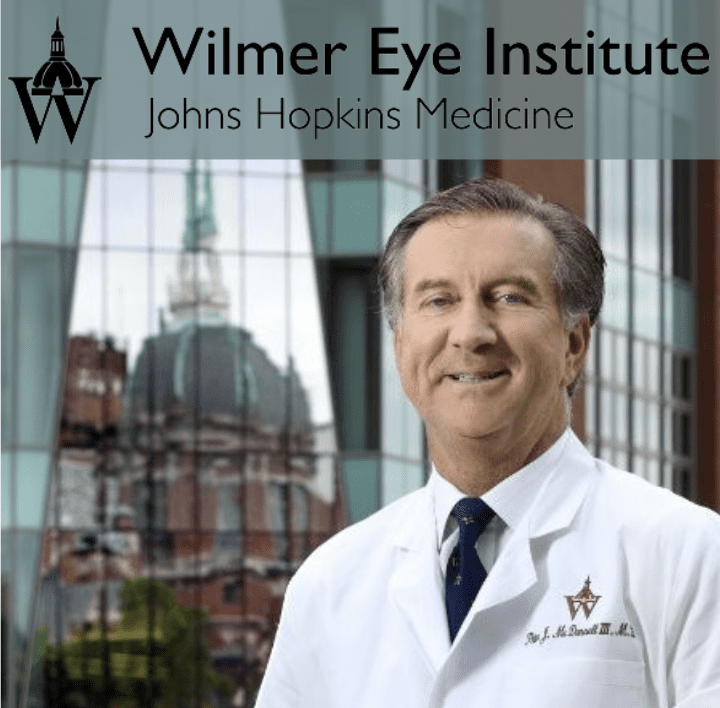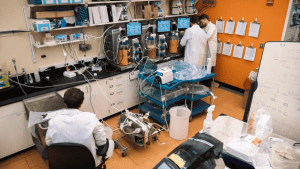
Johns Hopkins Wilmer Eye Institute Receives $20 Million Donation from T. Boone Pickens Foundation
Additional funding from the T. Boone Pickens Foundation will create additional Professorships for young researchers at the Johns Hopkins Wilmer Eye Institute. For almost 100 years the Wilmer Institute has blended eye research, clinical treatment and education, with one of the largest sources of biotech spinouts at Johns Hopkins Medicine.
By Mark Terry | August 17, 2023
| BioBuzz has been connecting the life science workforce since 2009. We’ve built an expansive community in the Mid-Atlantic with a national readership that spans from Massachusettes to Florida, and New York to California. For our next chapter, we’re building a proprietary talent logistics model to help employers source and hire life science talent. Learn more. |
The Johns Hopkins Wilmer Eye Institute recently received a $20 million donation from the T. Boone Pickens Foundation. Founded in 1925, the Wilmer Eye Institute has grown to see 270,000 patients annually, conduct 15,000 surgeries per year, and host 13 core research centers. It ranks a close second to cancer in terms of biotech spinouts from Johns Hopkins Medicine.
Business magnate and philanthropist T. Boone Pickens became interested in eye disease research and treatment after his father’s macular degeneration diagnosis in the 1980s. Pickens later developed macular degeneration himself, an age-related disease that blurs central vision. But before he did, he developed cataracts and had cataract surgery performed at Wilmer.
Peter McDonnell, MD, Director of the Wilmer Eye Institute, told BioBuzz, “Fortunately, treatments have dramatically improved in the last decade or so. Mr. Pickens felt that Wilmer had done a very good job in helping him to maintain his vision until the end of his long life. So he shared with me that he wanted to do something that would support Wilmer and also honor the name of our benefactor, Mr. Pickens.”
Pickens made gifts to Wilmer in 2005 and 2009 totaling $8 million. These were used first to establish the Boone Pickens Professorship of Ophthalmology, which is currently held by Amir Kashani, MD, PhD. Secondly, the funds were used to help build the Robert H. and Clarice Smith Building, which is the site of Wilmer’s research laboratories and operating rooms.
The additional $20 million gift will be used to fund research and the Boone Pickens Professorship, as well as new professorships for young investigators called the Boone Pickens Rising Professorships.
McDonnell said, “Mr. Pickens chose to fund these professorships, but for young people. Most professors receive these types of awards towards the end of their careers, after a long, distinguished career, sort of like an honor. Mr. Pickens was excited about accelerating the discoveries and the work of young people. So his professorships will be going to some of these young researchers that we have here who are full of new and exciting ideas, including this first recipient, who will receive some of the funds from the Pickens Foundation.”
McDonnell indicates the Pickens Rising Professors will accelerate the institute’s work in artificial intelligence, stem cells, nanotechnology and other frontiers of eye diseases.
The first recipient of a Boone Foundation Rising Professorship is Sheikh Amer Riazuddin, PhD, MS, Associate Professor of Ophthalmology. Riazuddin has also received funding from the Maryland Stem Cell Research Fund and Maryland Innovation Grants to support his research into stem cell-derived corneal endothelial cells for corneal endothelial keratoplasty.
McDonnell notes that they now have more than 60 professorships, often with matching funds from different sources. “We have a large number, which means I have trouble keeping track of them all. That’s a good problem to have.”
And as mentioned earlier, the Wilmer Eye Institute is a major source of commercial biotech spinouts from Johns Hopkins Medicine. Some of those include:
• Ocular Biologics, which was founded by Riazuddin, who is President and Chief Executive Officer. The company was founded in 2022 and focuses on the use of pluripotent stem cell-derived corneal endothelial cells.
• Graybug Vision, which spun out of Hopkins in 2011. The company was acquired by CalciMedica in November 2022.
• Asclepix Therapeutics, also founded in 2011, is focused on developing novel therapeutics for retinal diseases and cancer. In July 2023, the company announced it had secured a $10 million Series A-3 financing, which it expects to use in part to fund the DISCOVER trial of AXT107 microparticulate suspension in patients with wet age-related macular degeneration (wet AMD).
McDonnell mused that when he came to Johns Hopkins as a medical student in 1978, academics and researchers were discouraged from working with commercial companies. “I would have professors say to me, ‘We care for the sick. We don’t profit off them,’ as though it was a bad thing to be in industry.”
Yet, he says that over time, the university and various departments were trying to better understand how to measure the impact of their research. If you looked at grant dollars at Johns Hopkins, it was right at the top. And if you looked at the number of published papers in prestigious journals, it would be at the top or near the top. “But if you looked at companies and products that touched the lives of patients, we were nowhere near the top.”
This ultimately led to the question, he said, “If we’re doing such good work and it’s so meaningful, why has it not been translated into companies and products and medicines and devices that doctors are giving to millions of patients every year?”
There has since been a shift at universities and research institutions around the country and the world, not just at Johns Hopkins.
“During my time in 20 years of serving as chair of Wilmer, I’ve seen a sea change in the perception of how to take research and use it to benefit mankind,” McDonnell said. He also thinks that the taxpayers in Maryland saw institutions like Johns Hopkins receiving so many tax dollars in research funding that they wanted to see related to jobs from biotech.
“I have this bright, brilliant faculty with a million ideas. And I think a fair number of them were very excited at the prospect of living to see something that they had discovered in a laboratory turn into a treatment that would benefit many patients. I’m very happy to see this happen. It’s probably one of the greatest things that can happen to a researcher, to a professor, is to see something that he or she discovered turn into a treatment for lots of patients,” McDonnell told BioBuzz.
And in musing over the impact of the Pickens Professorships and Pickens Rising Professorships, McDonell mentions the Lucasian Professorship at the University of Cambridge, England, which was founded in 1663. The second person to receive it was Isaac Newton in 1660, while more than three hundred years later, in 1979, it was held by Stephen Hawking, with numerous luminaries of physics and mathematics holding the position in between and continuing onward.
“Mr. Pickens was very clear to me toward the end of his life that he was concerned about his legacy, and he didn’t want his name to be forgotten. I assured him that through the work of the people who will receive these professorships, every time they give a talk, every time they write a paper, every time someone writes a news article about them, his name will appear in it. So I’m hoping that all the people who will take these professorships and all the contributions they make in the future will honor Mr. Pickens’ legacy and that he will never be forgotten as a result of this.”
- About the Author
- Latest Posts
Mark Terry is a freelance writer, editor, novelist and ghostwriter. He holds a degree in microbiology & public health and spent 18 years in infectious disease research and clinical and research genetics prior to his transition to a writing career. His areas of expertise include biotechnology, pharma, clinical diagnostics, and medical practice management. He has written literally thousands of articles, as well as market research reports, white papers, more than 20 books, and many other written materials. He currently lives in Michigan with his family.







